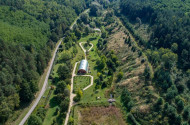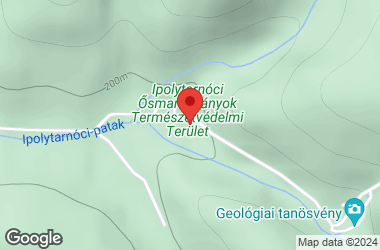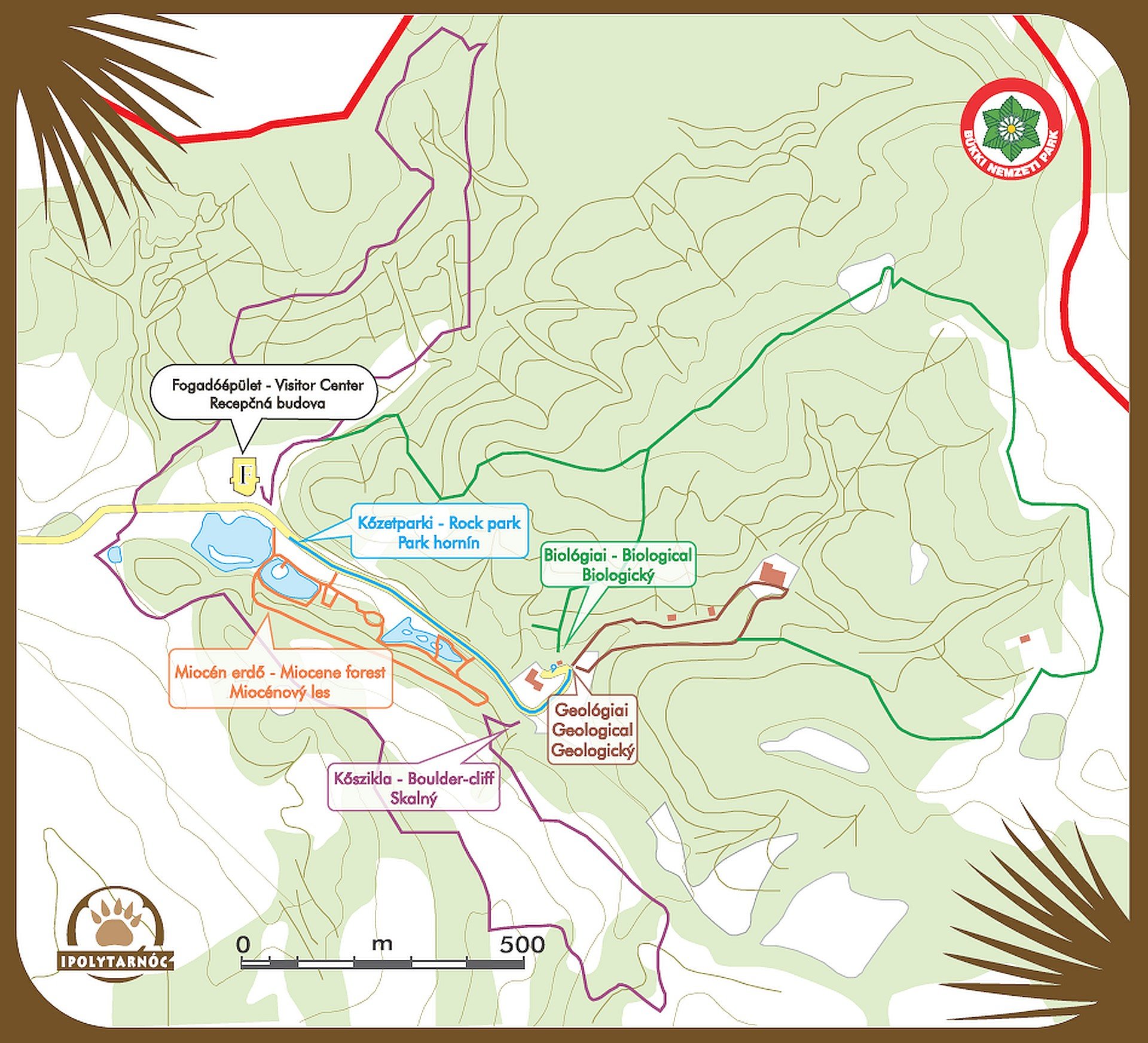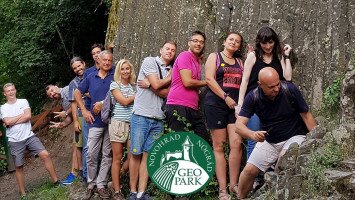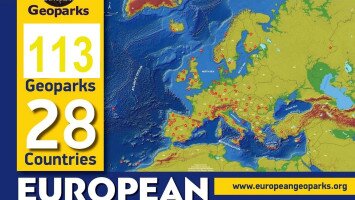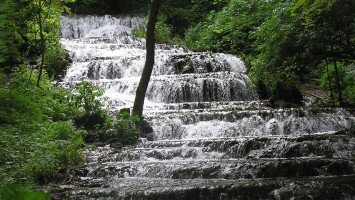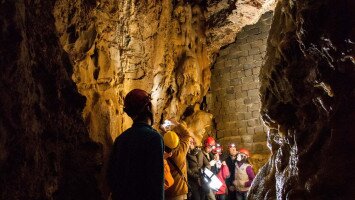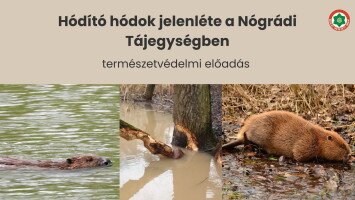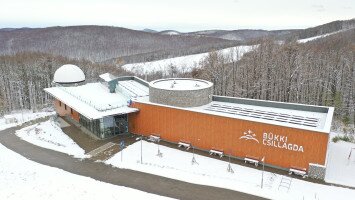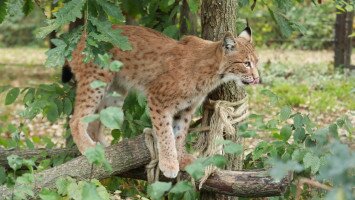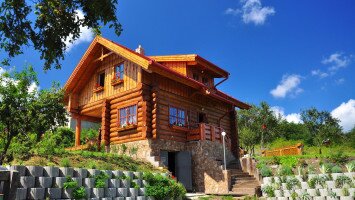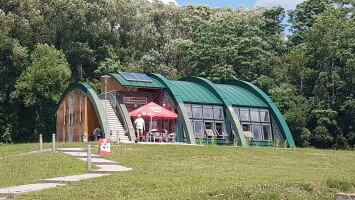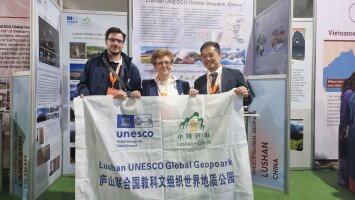
The visitor centre is the focal point of our trail network. The Boulder-cliff and Biological trails have some risk of ticks, closed clothing and field footwear is advised when walking on them.
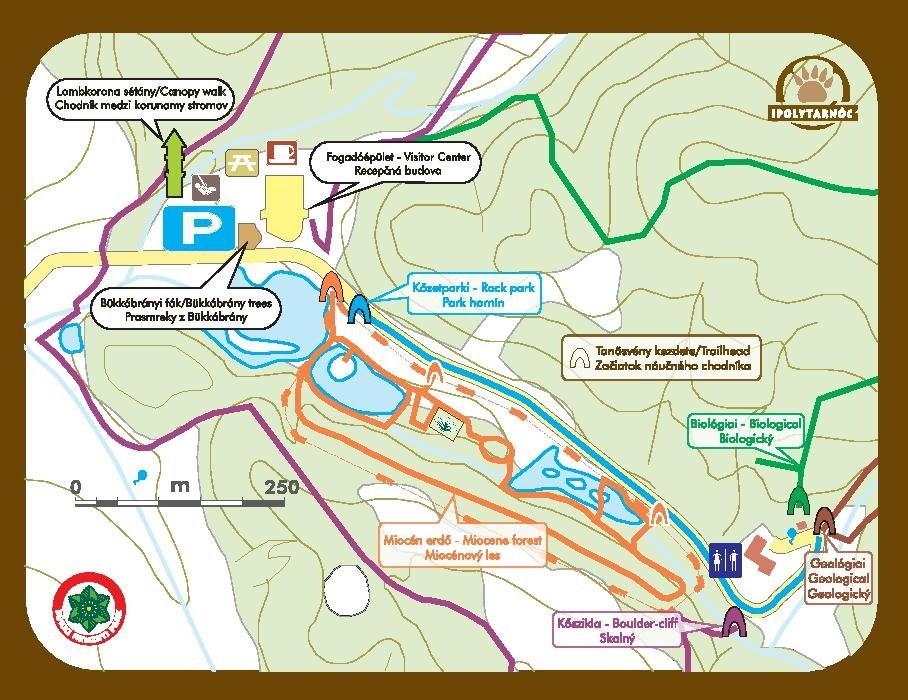 There is a Guide@Hand mobile, smartphone application, which can be used on the trail network of Ipolytarnoc. It can be downloaded at the Visitor Centre or here, do not miss it.
There is a Guide@Hand mobile, smartphone application, which can be used on the trail network of Ipolytarnoc. It can be downloaded at the Visitor Centre or here, do not miss it.
Geological Study Trail: The Ancient Pine Tree
At the beginning of the Geological study trail, you can see the sediments that covered the bed of the tropical sea 24 million years ago. Shark teeth those were sold as petrified bird tongues for the tourists by the residents at the beginning of the 20th century were found in these sediments. Later during the researches, among the shark teeth, remains of rays, bony fishes and bones of crocodiles, dolphins and sea cows were found in the sedimentary rocks.
The middle part of the trail is ruled by the 18-17 million years old dry land layers, which served as home of tropical rainforests interveawed by dwarf palmettos (Sabal minor). The multilevelled flora was ruled by palms, magnolias and laurels accompanied by huge, outstanding pine trees. Due to natural conservating mechanisms the volcanic rocks of Ipolytarnóc hide a petrified forest, thus prints of plants and petrified tree trunks are quite frequent in this area. The giant pine that spanned creek Borókás as a natural stonebridge was an organic part of the landscape for centuries. The huge silicified tree was a real giant of its own age topping 90 meters when it lived and had a circumference of 8 meters at the time it was found, so it became the biggest petrified member of the pine- family. Unfortunately a great part of it was carried away and got built into the houses of this area or gravestones, rock gardens, souvenirs were made of them, but later several pieces of it got into museums. Its death was caused by the rollig tuff flood of the volcanic catastrophe preserving it for succeeding generations. Three fairly big pieces of the gigantic sized sugar pines can be seen in their original position: the thicker remains of its trunk are preserved under protecting vault and the thinner branches in the main hall.
Geological Study Trail: Traces of the Ancient World
Almost 17 million years ago in the region of Ipolytarnóc a subtropical jungle grew wild which was stocked with vegetal and animal kingdoms that became almost extinct and they are unknown these days. Later a powerful volcanic eruption demolished the prehistoric vegetation, but due to the special conserving circumstances and the volcanic ash that burried everything under itself, if we visit Ipolytarnóc today, petrified marks of those day’s flora and fauna reveal themselves.
The ancient climate was characterized by an average temperature of 25°C and an annual precipitation of more than three thousand millimetres. The laurel flora mainly consisting of paleotropical elements is unfamiliar in the prehistoric European vegetation thus it represents a rainforest that was located on a plot of land, that earlier moved towards North between Africa and Europe. Due to all these the Natural Preserve of Ipolytarnóc opens up a unique vegetation which has an own specific name in the scientific literature (Florenkomplex Ipolytarnóc) and up to now more than 15 thousand leafprints of the fossil flora has been placed in museums.
Mainly at shallows and watering holes of the ancient surface, besides vegetal fossils you can find snapshots of outstanding value, marks of species of animals those became extinct long ago. Due to these Ipolytarnóc is one of the richest complex footprint site. During the exploring works of the path, winding along the banks of the prehistoric rivers, more than 3 thousand footprints of 11 species were identified, but beside the footprints of predatory animals, ancient rhinos, even-toed ungulates and birds, traces of animals those were resting and the ones those slipped in the mud or even ripples on the water and raindrops were the petrified into the warp. At the end of the trail, in the great hall which protects the footprint site the ancient world comes alive by way of a 3D animation.
Rock Park and Boulder Cliff Study Trails
A 700-meter-long track, the rock park path leads one from the visitor centre to the entrance of the geological study trail. On this trail every single step you make towards the entrance of the geological park brings you fifteen thousand years closer to the age of the 20-23 million-year-old rock layers. Labelled ”witness-stones”from every 2 million years and rock samples of this area help you spin back the wheel of time to experience their age.
The 4-kilometre-long Boulder Cliff study trail, which starts 100 metres away from the geological study trail, beside the upper car-park, passes by Botos- graben and ends at the visitor centre, leads its visitors along rock exposures, gullies, left stone- pits and ruins of farmsteads. Some parts of it, mainly the second one, are quite steep therefore one needs to be prepared for it but the experience after climbing is well worth trying.
During your walk on the trails remember you are in a protected area. It is forbidden to collect natural values and to disturb formations!
Title: Biological Study Trail
The originally indigenous oak forests of Ipolytarnóc were lumbered in the 18th century. After this some parts of it was under crop while the rest served as grazing lands. Towards the beginning of the 19th century a part of it was afforested with robinia- saplings (Robinia pseudoacacia) later black pines (Pinus nigra) and Scotch pines (Pinus sylvestris) some places oak trees were planted into the pasture lands. On those parts of the open country that was uncultivated a natural reforestation has started by juniper, hazel, birch, aspen and pine species. At more and more places, under the protecting microclimate of the shrubs regrowth of oak and Austrian oak can be found.
The sylviculture of Ipolytarnóc is lead by the priciples of the most minimal intervention and nature preservation but the facilitation of the headway of indigenous tree species is the longdistance aim. The biological walks which start at the entrance of the geological study trail and end at the Visitor Centre offer a pleasant relaxation while you can get know the flora and fauna of this area. The 2 and 4 kilometre-long forest-paths are varied by picnic areas, a look-out tower and memorial places of local quarrying.
Swamp Cypresses (Taxodum dstichum)
In the summer of 2007 very rare prehistoric remains were found in the lignite mine of Bükkábrány: Miners found trunks of 15 swamp cypresses 60 metres under the earlier surface, during exploitating works. These trees which used to live at the shores of the Pannonian Sea, under subtropical circumstances, 8 million years ago, are unique because they were conservated in their original shape and texture by the humid sand they were burreid into. Such an old forest, in its original state has never been found before.
During rescue excavation it was a serious problem that there was no elaborated technology for either transporting or conserving these trunks. Professionals of the Bükk National Park, applied a new method that was never used before: on the spot by using high pressure air compressors they blew out the sand from the surface of the trees, then injected a glue-like material into the outer parts of the trees.
The turnks those had a height of 3-5 meters, a diameter of 2-3 meters and a weight of 7-13 tons, arrived in Ipolytarnóc in September 2007 on specials vehicles of conveyance. After getting to their final place a protecting building was built over them. The significance of these extraordinary findsaving and conservating works is increased by the worldwide unique and outstanding achievements of Hungarian scientists in conservating and preserving these fossil remains.Miocene ForestIn the hilly country, beside the road that goes from the Visitor Centre to the entrace of the Geological Study Trail a new 2.5-hectar-sized arboretum is expecting its visitors hiding moory habitats and clearings, where you can get acquainted with the flora and the fauna of the miocenic age by the help of plants and reproductions of animals. Walking along the path spanning through foot bridges and cut up by picnic areas, among the plants which came from the Orient or the American continent you can find the lifelike statues of every miocenic animal, whose petrified footprints got identified in the clay of Ipolytarnóc.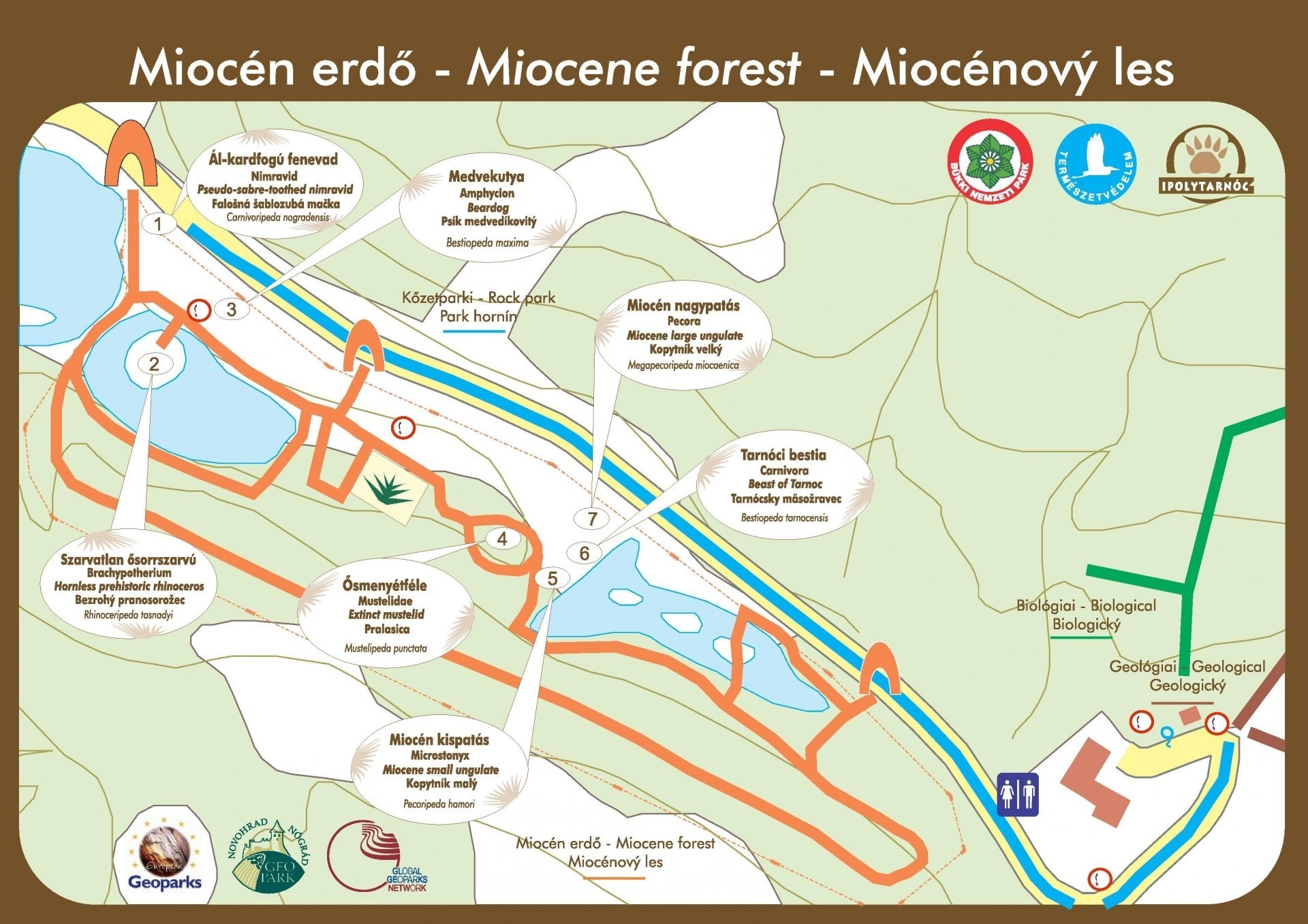
In the middle of the arboretum you can find a greenhouse which is architecturally showy and harmoniously fits its environment. Travellers can get know the characteristic plants of the Tertiary in it but due to the cooling of the climate got finally disappeared from the area and now they would not be able to survive the frosty months in wintertime. This greenhouse gives place to the early raising of the individuals of the plant species which can be found out of the building.
